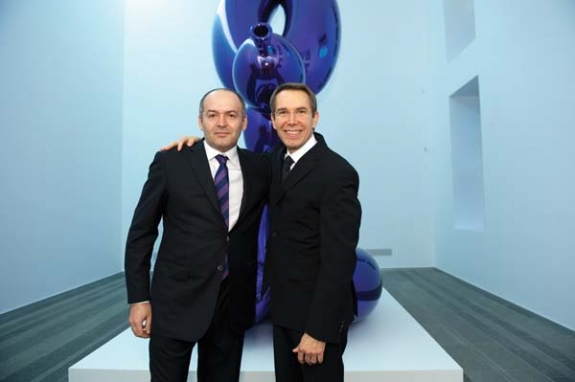Post-Soviet Kiev is a city in transformation. There are new shops and restaurants; airports are expanding, and the Olympic stadium is being revamped in preparation for the 2012 European football championships to be hosted jointly by Ukraine and Poland. But perhaps nothing exemplifies change in the country’s capital so much as the crowds queuing up to see sharks in formaldehyde, balloon rabbits in stainless steel, and sculptures of sperm-wielding adolescents, works by Damien Hirst, Jeff Koons and Takashi Murakami respectively. All three artists have been shown for the first time in Ukraine at the Pinchuk Art Centre (PAC), a private museum of contemporary art in the centre of Kiev, which has just celebrated its fifth birthday.
Since its opening in 2006, nearly 1.2 million people have visited the gallery, which charges no admission and also includes a bookshop and a trendy bar with views over the city. Of these visitors, 60% are aged between 16 and 30. “Our society, especially young people, accepted contemporary art in a great way, in an unexpected way… there is a huge appetite for it,” says Victor Pinchuk, the steel magnate and billionaire who finances the museum and who has put himself at the centre of efforts to modernise Ukraine.
Pinchuk recently gave The Art Newspaper a rare interview on his estate outside Kiev, where he told us the success of his gallery has encouraged him to attempt a bigger, much more ambitious museum project. PAC is currently housed in an early 20th-century building in central Kiev which was once a hotel. But Pinchuk now wants to give it a new home in a purpose-built gallery designed by a top international architectural firm.
“It has to be an important building for our country, for our city. It has to be a destination for sightseeing tours in Kiev. I hope the image of this art centre will be on the most popular postcards… it has to be,” he says.
PAC hosts temporary exhibitions curated by museum staff and also shows a rotating display of work from Pinchuk’s own collection. The new gallery, in an “iconic” building, will do the same, says Pinchuk, who believes it could be ready within five years. He will not reveal the architects he is considering for the museum, however sources close to the project suggest Switzerland’s Herzog & de Meuron have been hired for the job.
An embarrassment of riches
Victor Pinchuk is an easy man to like. He is funny and charming and likes to gossip. He is also very, very rich. He trained as an engineer in the Soviet era, gaining a PhD from the Metallurgical Institute in Dnipropetrovsk in eastern Ukraine, before setting up his own company in 1990 to manufacture a new kind of metal tubing that he had invented. He went on to sell it all over the former Soviet Union. His fortune increased further after he met and married Elena, the daughter of the ex-president of Ukraine, Leonid Kuchma. The family connection helped Pinchuk secure Ukraine’s Kryvorizhstal steel company for $850m when the industry was privatised. Following the Orange Revolution, the sale was rescinded and the company was sold again, this time to Indian steel magnate Lakshmi Mittal for $4.8bn. Despite the setback, Pinchuk has gone on to even greater success. He diversified and in 2006 set up EastOne Ltd, an investment advisory company which controls several TV stations and the most popular tabloid newspaper in the country, as well as multiple industrial assets. Today, Forbes estimates Pinchuk’s fortune at $3.3bn.
With that much spending power comes enormous influence. Although Pinchuk has only taken a serious interest in art in the last five years, he is courted by museum directors the world over. When Pinchuk asks for a favour, one imagines few turn him down. Alfred Pacquement, Glenn Lowry, Richard Armstrong and Nicholas Serota, respectively directors of the Pompidou, MoMA, the Guggenheim and Tate, all serve on the board of Pinchuk’s Future Generation Art Prize, a $100,000 award given every two years to an artist under 35 of any nationality.



